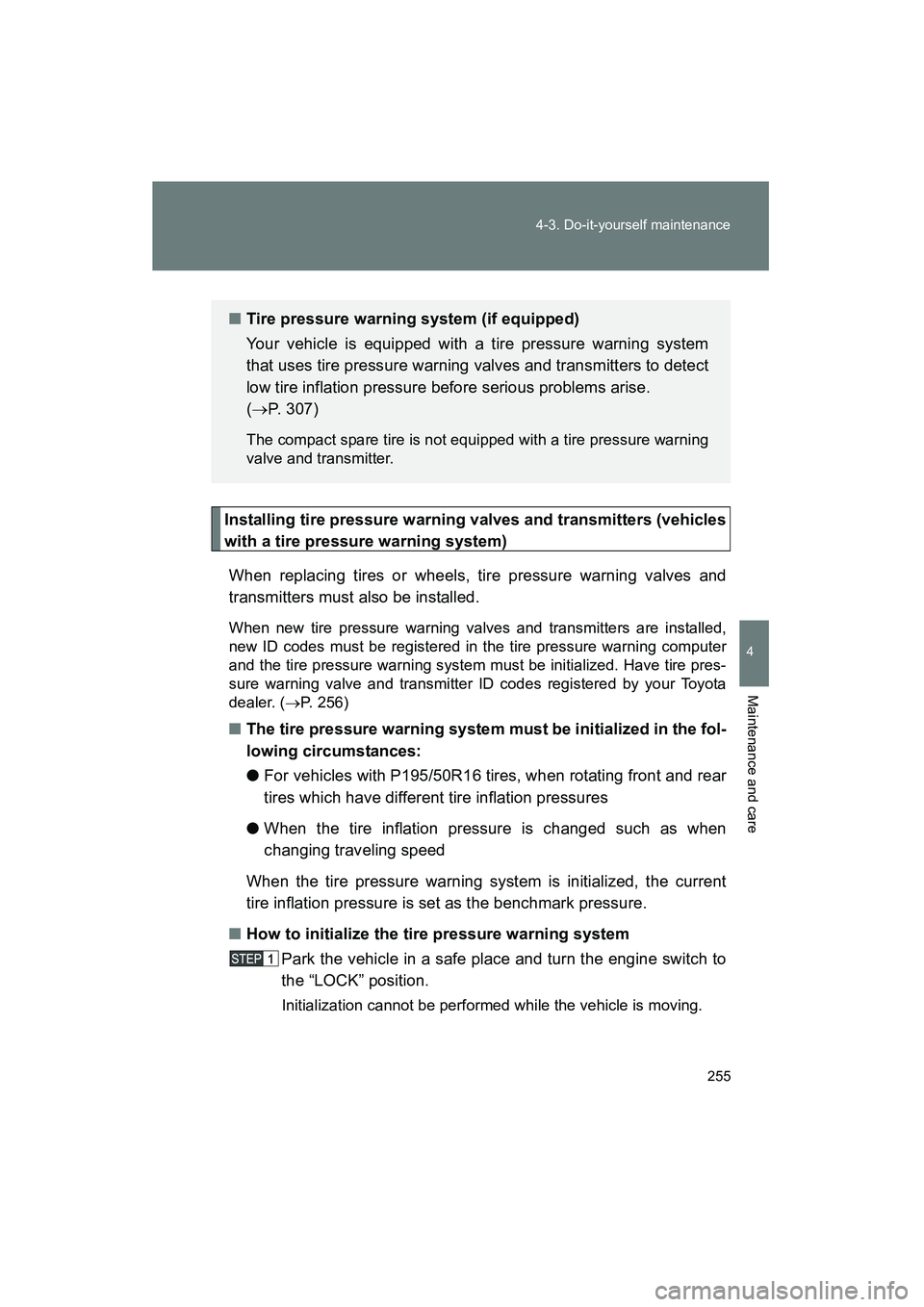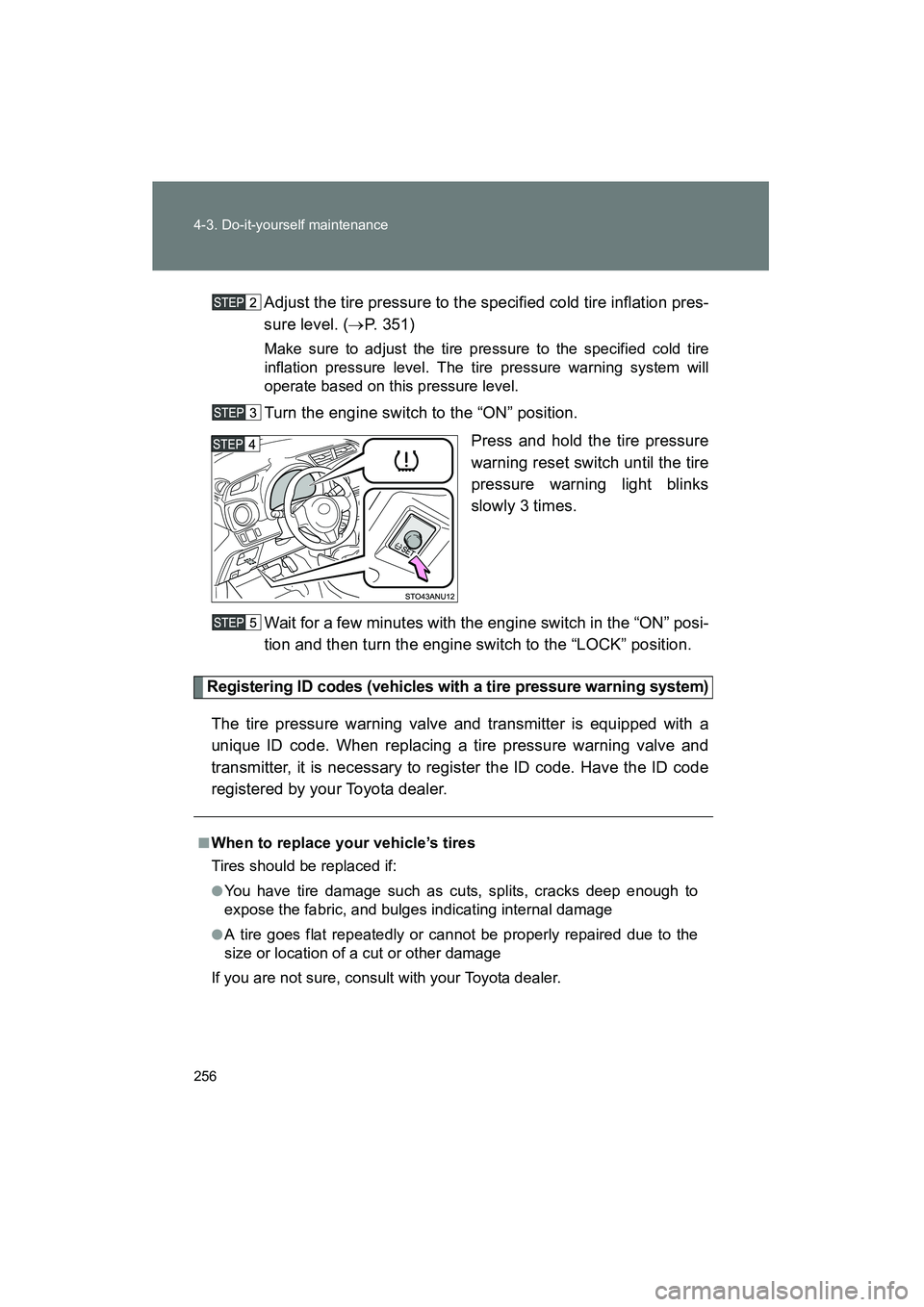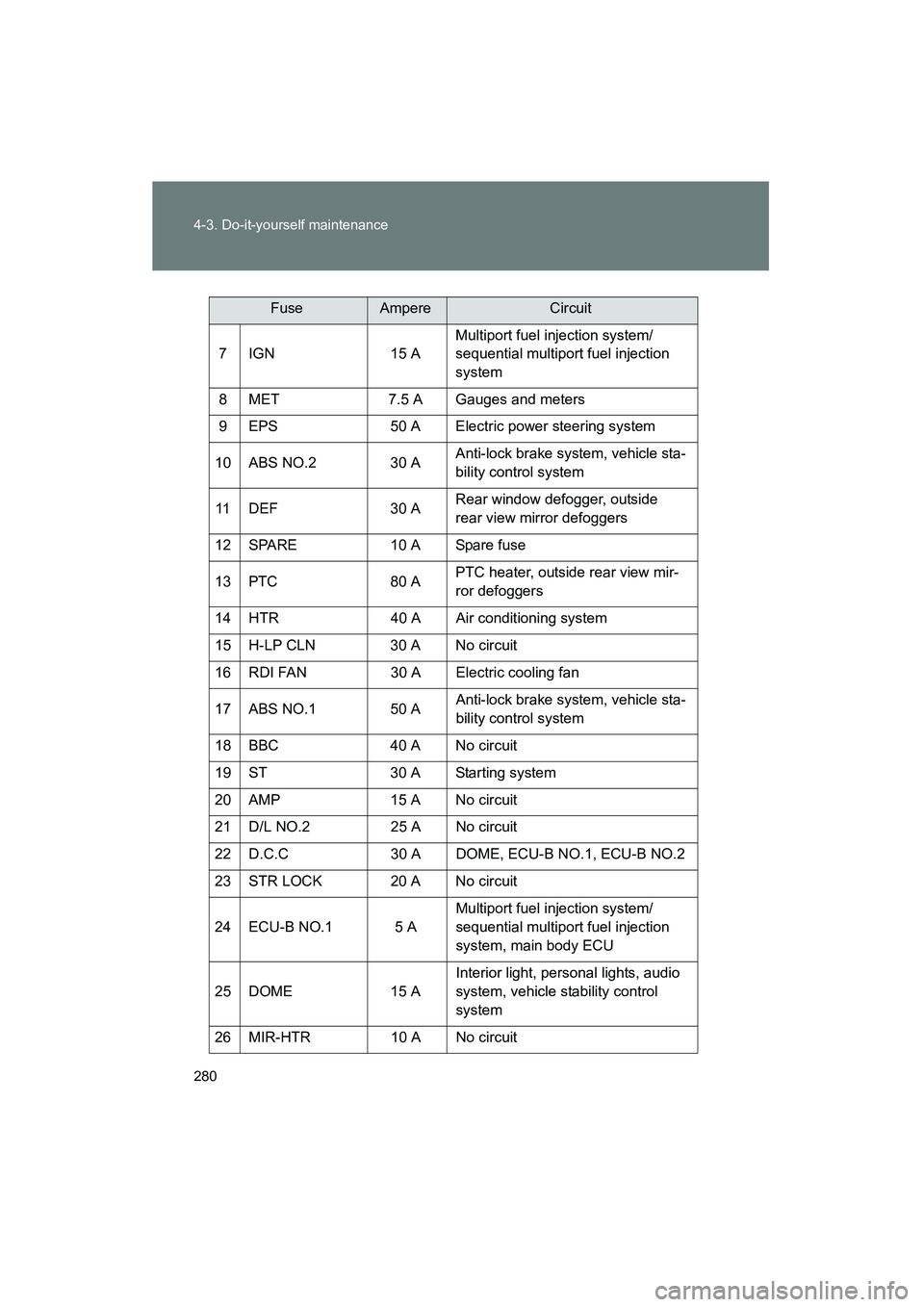Page 241 of 403
239
4-3. Do-it-yourself maintenance
4
Maintenance and care
YARIS_HB_U_52D44U
CAUTION
■
Pre-driving check
Check that the hood is fully closed and locked.
If the hood is not locked properly, it may open while the vehicle is in motion
and cause an accident, which may result in death or serious injury.
■ After installing the support rod into the slot
Make sure the rod supports the hood securely from falling down on to your
head or body.
NOTICE
■When closing the hood
Be sure to return the support rod to its clip before closing the hood. Closing
the hood with the support rod up could cause the hood to bend.
Page 247 of 403

245
4-3. Do-it-yourself maintenance
4
Maintenance and care
YARIS_HB_U_52D44U
■
Adding engine oil
If the oil level is below or near
the low level mark, add engine
oil of the same type as that
already in the engine.
Make sure to check the oil type and prepare the items needed before
adding oil.
Remove the oil filler cap by turning it counterclockwise.
Add engine oil slowly, checking the dipstick.
Install the oil filler cap by turning it clockwise.
Engine oil selection →P. 346
Oil quantity
(Low → Full) 1.6 qt. (1.5 L, 1.3 lmp.qt.)
Item
Clean funnel
■ Engine oil consumption
A certain amount of engine oil will be consumed while driving. In the follow-
ing situations, oil consumption may increase, and engine oil may need to be
refilled in between oil maintenance intervals.
●When the engine is new, for example dire ctly after purchasing the vehicle
or after replacing the engine
● If low quality oil or oil of an inappropriate viscosity is used
● When driving at high engine speeds or with a heavy load, when towing,
or when driving while accelerating or decelerating frequently
● When leaving the engine idling for a long time, or when driving frequently
thorough heavy traffic
Page 257 of 403

255
4-3. Do-it-yourself maintenance
4
Maintenance and care
YARIS_HB_U_52D44U
Installing tire pressure warning valves and transmitters (vehicles
with a tire pressure warning system)
When replacing tires or wheels, tire pressure warning valves and
transmitters must also be installed.
When new tire pressure warning valves and transmitters are installed,
new ID codes must be registered in the tire pressure warning computer
and the tire pressure warning system must be initialized. Have tire pres-
sure warning valve and transmitter ID codes registered by your Toyota
dealer. ( →P. 256)
■ The tire pressure warning system must be initialized in the fol-
lowing circumstances:
● For vehicles with P195/50R16 tires, when rotating front and rear
tires which have different tire inflation pressures
● When the tire inflation pressure is changed such as when
changing traveling speed
When the tire pressure warning system is initialized, the current
tire inflation pressure is set as the benchmark pressure.
■ How to initialize the tire pressure warning system
Park the vehicle in a safe place and turn the engine switch to
the “LOCK” position.
Initialization cannot be performed while the vehicle is moving.
■Tire pressure warning system (if equipped)
Your vehicle is equipped with a tire pressure warning system
that uses tire pressure warning valves and transmitters to detect
low tire inflation pressure before serious problems arise.
(→ P. 307)
The compact spare tire is not equipped with a tire pressure warning
valve and transmitter.
Page 258 of 403

256 4-3. Do-it-yourself maintenance
YARIS_HB_U_52D44UAdjust the tire pressure to the specified cold tire inflation pres-
sure level. (
→P. 351)
Make sure to adjust the tire pressure to the specified cold tire
inflation pressure level. The tire pressure warning system will
operate based on this pressure level.
Turn the engine switch to the “ON” position.
Press and hold the tire pressure
warning reset switch until the tire
pressure warning light blinks
slowly 3 times.
Wait for a few minutes with the engine switch in the “ON” posi-
tion and then turn the engine switch to the “LOCK” position.
Registering ID codes (vehicles with a tire pressure warning system)
The tire pressure warning valve and transmitter is equipped with a
unique ID code. When replacing a tire pressure warning valve and
transmitter, it is necessary to register the ID code. Have the ID code
registered by your Toyota dealer.
■When to replace your vehicle’s tires
Tires should be replaced if:
●You have tire damage such as cuts, splits, cracks deep enough to
expose the fabric, and bulges indicating internal damage
●A tire goes flat repeatedly or cannot be properly repaired due to the
size or location of a cut or other damage
If you are not sure, consult with your Toyota dealer.
Page 271 of 403
269
4-3. Do-it-yourself maintenance
4
Maintenance and care
YARIS_HB_U_52D44U
Air conditioning filter
The air conditioning filter must be changed regularly to maintain air
conditioning efficiency.
■Replacement method
Turn the engine switch to the “LOCK” position.
Open the glove box. Slide off
the damper.
Press the outer facing side of
the glove box to disconnect
the upper claws.
Pull out the glove box and dis-
connect the lower claws.
Page 277 of 403
275
4-3. Do-it-yourself maintenance
4
Maintenance and care
YARIS_HB_U_52D44U
Checking and replacing fuses
If any of the electrical components do not operate, a fuse may have
blown. If this happens, check and replace the fuses as necessary.
Turn the engine switch to the “LOCK” position.
Open the fuse box cover.
Engine compartment (type A fuse box) Push the tab in and lift the lid
off.
Engine compartment (type B fuse box) Push the tab in and lift the lid
off.
Engine compartment (type C fuse box) Pull the rubber strip on the
edge to unhook it from the
cover, and then push the
tabs in and lift the cover off.
Page 282 of 403

280 4-3. Do-it-yourself maintenance
YARIS_HB_U_52D44U
7 IGN15 AMultiport fuel injection system/
sequential multiport fuel injection
system
8 MET 7.5 A Gauges and meters
9 EPS 50 A Electric power steering system
10 ABS NO.2 30 AAnti-lock brake system, vehicle sta-
bility control system
11 DEF 30 ARear window defogger, outside
rear view mirror defoggers
12 SPARE 10 A Spare fuse
13 PTC 80 APTC heater, outside rear view mir-
ror defoggers
14 HTR 40 A Air conditioning system
15 H-LP CLN 30 A No circuit
16 RDI FAN 30 A Electric cooling fan
17 ABS NO.1 50 AAnti-lock brake system, vehicle sta-
bility control system
18 BBC 40 A No circuit
19 ST 30 A Starting system
20 AMP 15 A No circuit
21 D/L NO.2 25 A No circuit
22 D.C.C 30 A DOME, ECU-B NO.1, ECU-B NO.2
23 STR LOCK 20 A No circuit
24 ECU-B NO.1 5 A Multiport fuel injection system/
sequential multiport fuel injection
system, main body ECU
25 DOME 15 AInterior light, personal lights, audio
system, vehicle stability control
system
26 MIR-HTR 10 A No circuit
FuseAmpereCircuit
Page 285 of 403
283
4-3. Do-it-yourself maintenance
4
Maintenance and care
YARIS_HB_U_52D44U
Engine compartment (type C fuse box)
FuseAmpereCircuit
1 ALT 120 AID/UP, EPS, ABS NO.2, DEF, PTC,
HTR, H-LP CLN, RDI FAN, ABS
NO.1, TAIL NO.2, PANEL, DOOR
R/R, DOOR P, ECU-IG NO.1,
ECU-IG NO.2, A/C, GAUGE,
WASHER, WIPER, WIPER RR,
P/W, DOOR R/L, DOOR, CIG,
ACC, D/L, OBD, STOP, AM1, FOG
FR
2 MAIN 80 ABBC, ST, AMP, D/L NO.2, D.C.C,
STR LOCK, MIR-HTR, ETCS,
HAZ, AM2, ALT-S, R/I, EU-DRL,
S-HORN, H-LP MAIN, H-LP RH HI,
H-LP LH HI, H-LP RH LO, H-LP LH
LO